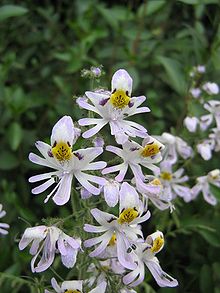Split flowers
| Split flowers | ||||||||||||
|---|---|---|---|---|---|---|---|---|---|---|---|---|

Schizanthus grahamii , illustration |
||||||||||||
| Systematics | ||||||||||||
|
||||||||||||
| Scientific name | ||||||||||||
| Schizanthus | ||||||||||||
| Ruiz & Pav. |
The split flowers ( Schizanthus ) or butterfly flowers form the only genus of the subfamily Schizanthoideae within the nightshade family (Solanaceae). Mainly because of the strongly zygomorphic flowers, they differ greatly from other members of the family. The genus is endemic to Chile . Synonyms for gap flower are peasant orchid (a marketing name) or orchid of the little man .
description
Vegetative characteristics
Split flowers are annual or biennial herbaceous plants with a partially woody base that reach heights of (25 to) 75 (to 100) cm. The surface of the entire plant is usually sticky due to glandular trichomes . The heavily pinnate leaves are 3 to 9 (14) cm long. The individual pinnate leaf parts are distant, with entire margins, slightly jagged, lobed, pinnate or coved.
blossoms
The zygomorphic flower is fivefold. The flower stalks are 3 to 25 mm long, growing, sometimes bent back. At flowering time, the flowers are rotated by about 72 degrees. The calyx is (2) 5 to 8 (13) mm long, the individual segments slightly different, linear or spatulate, narrow, blunt. In contrast to most of the other nightshade family, the sepals are hardly fused together. The crown is (7) 14–44 mm long, the crown tube 8 to 28 mm, sometimes only 1.5 to 4 mm. The five petals are shaped very differently: one standing in front, two on the side and two standing back, with the latter being combined into a boat. The flowers are usually monochrome or very differently multicolored, white only in exceptional cases. The fertile anthers are 1.8 to 3.2 mm long and sit on 3.3 to 4.8 mm long stamens. The sterile anthers are only 0.5 to 1 mm long and either sit on long stamens or are almost sessile.
Fruits and seeds
The fruits are ovate-prismatic capsule fruits with blunt or rounded tips. They are 4 to 10 mm long and usually contain 12 to 34 (rarely 9 to 40) seeds . The seeds measure 0.4 to 1 mm in diameter, are usually egg-shaped or kidney-shaped and then 1 to 2.1 mm long or rarely almost spherical.
ingredients
Split flowers differ from most other nightshade plants not only in their morphology , but also in the alkaloids they contain . Studies found 15 tropane alkaloids that are atypical for the family . Some of them contain structural properties typical of acid esters which have not been found in any other tropane alkaloid of the nightshade family.
Occurrence
The genus is native to Chile , can be found in the area between Antofagasta in the north to Lake Llanquihue in the south, two species can also be found in the border area on the Argentine side. Three species and some hybrids are cultivated as ornamental plants.
ecology
Most species are pollinated by bees , only three species by moths .
Systematics
External system
Within the nightshade family (Solanaceae), the slit flowers occupy a basal position; phylogenetic studies place the genus as a sister clade to the rest of the family. Many features, such as the strong zygomorphism of the flowers, only two fertile anthers and the rotation of the flowers is not found in other nightshade plants or within the sister family of the bindweed family (Convolvulaceae); therefore these features are interpreted as autapomorphies (derived features).

Internal system
Twelve species are distinguished within the genus:
- Schizanthus alpestris Poepp. ex Benth.
- Schizanthus candidus Lindl.
- Blunted split flower ( Schizanthus grahamii Gill. Ex Hooker ): It occurs in Argentina and Chile.
- Schizanthus hookeri Gillies ex Graham
- Schizanthus lacteus Phil.
- Schizanthus laetus Phil.
- Schizanthus litoralis Phil.
- Schizanthus integrifolius Phil.
- Schizanthus parvulus Sudzuki
- Pinnate split flower ( Schizanthus pinnatus Ruiz & Pav. ): It occurs only in Chile.
- Schizanthus porrigens Graham
- Schizanthus tricolor Gray & Gronb.
In addition, some hybrids are known (selection):
- Schizanthus hybridus
- Hybrid gapflower ( Schizanthus × wisetonensis H. Low ; Syn .: Schizanthus grahamii x Schizanthus pinnatus )
literature
- Armando T. Hunziker: The Genera of Solanaceae ARG Gantner Verlag KG, Ruggell, Liechtenstein 2001. ISBN 3-904144-77-4 .
Individual evidence
- ↑ Richard G. Olmstead et al .: A molecular phylogeny of the Solanaceae (PDF; 389 kB). In: Taxon , Volume 57, Number 4, November 2008. pp. 1159-1181.
- ↑ J. Grau and E. Gronbach: Investigations on the variability in the genus Schizanthus (Solanaceae) . In: Mitteilungen der Botanische Staatssammlung München , Volume 20, November 1984, pp. 111–203.
- ^ A b Schizanthus in the Germplasm Resources Information Network (GRIN), USDA , ARS , National Genetic Resources Program. National Germplasm Resources Laboratory, Beltsville, Maryland. Retrieved November 25, 2018.
Web links
- Schizanthus in the Flora of Chile. (Spanish)


